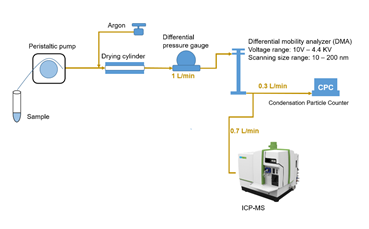Particle-size-resolved elemental analysis of road dust coupling SMPS to ICP-MS
Determining the size and composition of road dust particles is important to assess the hazard to public health, especially considering that non-exhaust emissions are on a rise trend [1]. Obviously, elements partitioned in the finer nano-fraction have much higher penetration in the human body. Therefore, accessing the size-dependent composition in an ambient mixture is a crucial task.
A state-of-the-art Scanning Mobility Particle Sizer (SMPS), consisting of a Differential Mobility Analyzer (DMA) and condensation Particle Counter (CPC) was coupled to inductively coupled plasma mass spectrometry (ICP-MS) for the elemental analysis. Instrumental challenges were overcome ranging from the acceptable gas flow rate for each of the two modules, sample uptake and calibration [2]. In order to mimic a settling event of the road dust particles, the studied materials were suspended and introduced into the system over a peristaltic pump and dried using a Drying cylinder as shown in the Figure and introduced into the SMPS and then into the ICP.
The experiments showed that this setup is capable to measure in the concentration range associated with road dust. Cu and Pb particle suspensions can be measured down to a concentration of 10µM which is well below common road dust concentrations of 1.9mM Cu and 0.302mM for Pb from suspending 1Kg of road dust[3]. The setup still needs to be tweaked to reduce the amount of sample that is needed and lower the detection limit further. Additionally the particle-size-resolved elemental analysis still needs further tweaking in the data analysis part to get to the resolution desired.

[1] R. M. Harrison, A. M. Jones, J. Gietl, J. Yin, D. C. Green, Environ. Sci. Technology, 2012, 46, 6523-6529
[2] A. Hess, M. Tarik, C. Ludwig, Journal Aerosol Science, 2015, 88, 109-118
[3] C. L. S. Wiseman, C. Levesque, P. E. Rasmussen, Sci Total Environ., 2021, 786, 147467